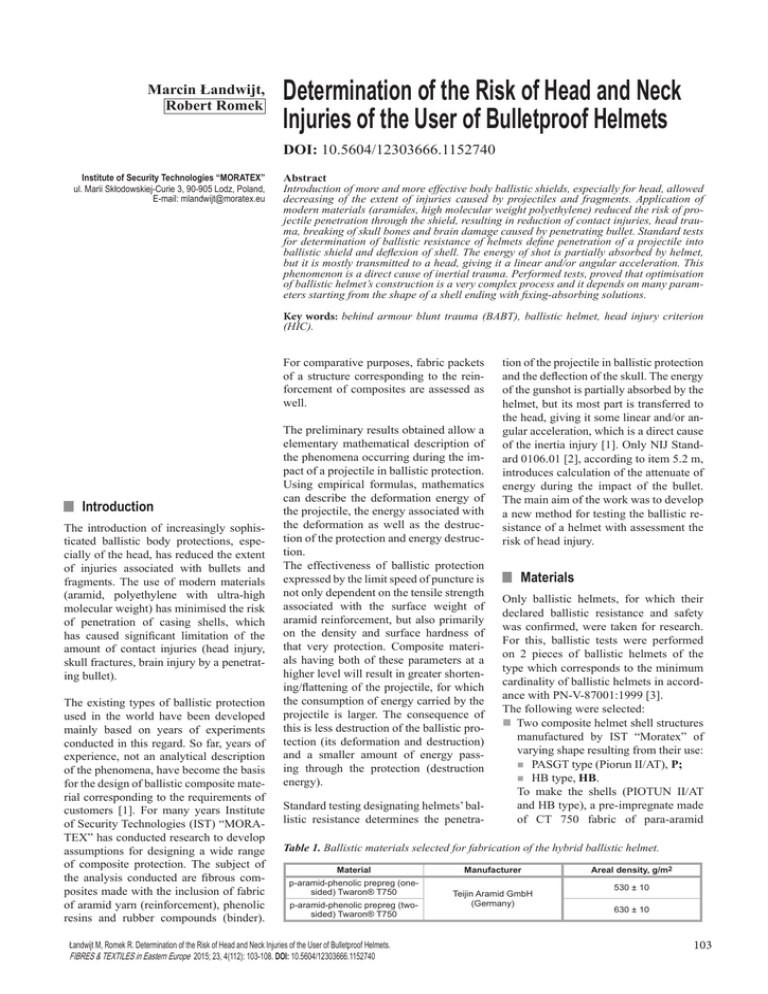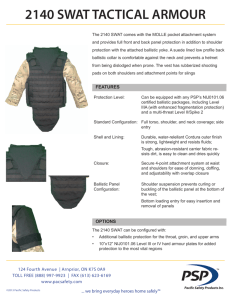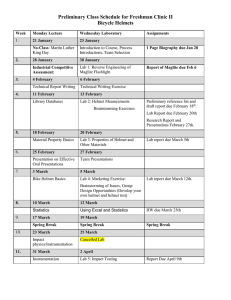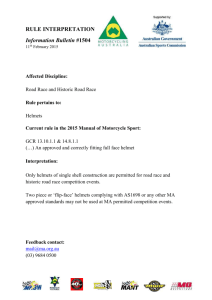Determination of the Risk of Head and Neck Marcin Łandwijt, Robert Romek
advertisement

Marcin Łandwijt, Robert Romek Determination of the Risk of Head and Neck Injuries of the User of Bulletproof Helmets DOI: 10.5604/12303666.1152740 Institute of Security Technologies “MORATEX” ul. Marii Skłodowskiej-Curie 3, 90-905 Lodz, Poland, E-mail: mlandwijt@moratex.eu Abstract Introduction of more and more effective body ballistic shields, especially for head, allowed decreasing of the extent of injuries caused by projectiles and fragments. Application of modern materials (aramides, high molecular weight polyethylene) reduced the risk of projectile penetration through the shield, resulting in reduction of contact injuries, head trauma, breaking of skull bones and brain damage caused by penetrating bullet. Standard tests for determination of ballistic resistance of helmets define penetration of a projectile into ballistic shield and deflexion of shell. The energy of shot is partially absorbed by helmet, but it is mostly transmitted to a head, giving it a linear and/or angular acceleration. This phenomenon is a direct cause of inertial trauma. Performed tests, proved that optimisation of ballistic helmet’s construction is a very complex process and it depends on many parameters starting from the shape of a shell ending with fixing-absorbing solutions. Key words: behind armour blunt trauma (BABT), ballistic helmet, head injury criterion (HIC). For comparative purposes, fabric packets of a structure corresponding to the reinforcement of composites are assessed as well. nIntroduction The introduction of increasingly sophisticated ballistic body protections, especially of the head, has reduced the extent of injuries associated with bullets and fragments. The use of modern materials (aramid, polyethylene with ultra-high molecular weight) has minimised the risk of penetration of casing shells, which has caused significant limitation of the amount of contact injuries (head injury, skull fractures, brain injury by a penetrating bullet). The existing types of ballistic protection used in the world have been developed mainly based on years of experiments conducted in this regard. So far, years of experience, not an analytical description of the phenomena, have become the basis for the design of ballistic composite material corresponding to the requirements of customers [1]. For many years Institute of Security Technologies (IST) “MORATEX” has conducted research to develop assumptions for designing a wide range of composite protection. The subject of the analysis conducted are fibrous composites made with the inclusion of fabric of aramid yarn (reinforcement), phenolic resins and rubber compounds (binder). The preliminary results obtained allow a elementary mathematical description of the phenomena occurring during the impact of a projectile in ballistic protection. Using empirical formulas, mathematics can describe the deformation energy of the projectile, the energy associated with the deformation as well as the destruction of the protection and energy destruction. The effectiveness of ballistic protection expressed by the limit speed of puncture is not only dependent on the tensile strength associated with the surface weight of aramid reinforcement, but also primarily on the density and surface hardness of that very protection. Composite materials having both of these parameters at a higher level will result in greater shortening/flattening of the projectile, for which the consumption of energy carried by the projectile is larger. The consequence of this is less destruction of the ballistic protection (its deformation and destruction) and a smaller amount of energy passing through the protection (destruction energy). Standard testing designating helmets’ ballistic resistance determines the penetra- tion of the projectile in ballistic protection and the deflection of the skull. The energy of the gunshot is partially absorbed by the helmet, but its most part is transferred to the head, giving it some linear and/or angular acceleration, which is a direct cause of the inertia injury [1]. Only NIJ Standard 0106.01 [2], according to item 5.2 m, introduces calculation of the attenuate of energy during the impact of the bullet. The main aim of the work was to develop a new method for testing the ballistic resistance of a helmet with assessment the risk of head injury. nMaterials Only ballistic helmets, for which their declared ballistic resistance and safety was confirmed, were taken for research. For this, ballistic tests were performed on 2 pieces of ballistic helmets of the type which corresponds to the minimum cardinality of ballistic helmets in accordance with PN-V-87001:1999 [3]. The following were selected: n Two composite helmet shell structures manufactured by IST “Moratex” of varying shape resulting from their use: nPASGT type (Piorun II/AT), P; nHB type, HB. To make the shells (PIOTUN II/AT and HB type), a pre-impregnate made of CT 750 fabric of para-aramid Table 1. Ballistic materials selected for fabrication of the hybrid ballistic helmet. Material p-aramid-phenolic prepreg (onesided) Twaron® T750 p-aramid-phenolic prepreg (twosided) Twaron® T750 Łandwijt M, Romek R. Determination of the Risk of Head and Neck Injuries of the User of Bulletproof Helmets. FIBRES & TEXTILES in Eastern Europe 2015; 23, 4(112): 103-108. DOI: 10.5604/12303666.1152740 Manufacturer Teijin Aramid GmbH (Germany) Areal density, g/m2 530 ± 10 630 ± 10 103 Twaron® fibres and phenolic resin modified with PVB (one and twosided prepreg) were used. The process of pressing the aramid pre-impregnates is performed at a temperature of 160 - 170 °C, under a pressure up to 30 MPa. n Two harness structures: nThree-point, 3, nFour-point with occipital padding, 4. n Five insides of cushioning structures, representing the four most common types: nbelt T, nNOSCHA N, nHB pad, npad 1, P1 (foam plastic), thickness 25 cm, npad 2, P2 (two polyurethane foams having a bulk density of 75 kg/m3, including one slow memory type thickness 25 mm. The following are example of helmets prepared for ballistic tests (Figure 1). nMethodology For determination of the energy, the use of a specially modified dummy for the project, the Dummy Hybrid model Hybrid III 50th Male Dummy by Denton ATD, Inc. “Head - neck”, was assumed, which corresponds to the properties of the human head and neck. On the outer surface of the helmet, four points of hits were marked (on the forehead, on the back and both sides). The points were determined so as to be in the area of the band designated by the two lines, one being distant from the periphery of the helmet by 4 cm and the other by 11 cm. They should be located closest to the trace resulting from the intersection of the plane of symmetry of the helmet and perpendicular to the plane passing through the axis of the construction of the shell. The points should also be distant from the edge of the helmet, anchorages and technological holes by at least 30 mm. Hit points should not be in the areas of material weakness of the shell caused by the previous shots. Before the tests the helmets, were air conditioned at a temperature of 20 ± 2 °C at a relative humidity of 65 ± 5% for 24 h. Only after such verification of the ballistic helmets was it possible to test the ballistic helmet mounted on the layout of the head (location of the points with respect to the dummy’s head is shown in Figure 2). Ballistic tests were carried out according to a modification of procedure of the project of the Ballistic Research Laboratory IST “Moratex”, PBB-04:1996 [5]. a) b) c) d) e) f) g) Figure 1. Ballistic helmet: a) Piorun + 3-point harness + belt (P3T), b) Piorun + 3-point harness + pad 1 (P3P1), c) Piorun + 4-point harness + HB pad (P3HB), d) Piorun + 3-point harness + pad 2 (P3P2), e) Piorun + 3-point harness + NOSCHA (P3N), f) Piorun + 4-point harness + NOSCHA (P4N), g) HB + 3-point harness + HB pad (HB3HB). 104 FIBRES & TEXTILES in Eastern Europe 2015, Vol. 23, 4(112) Modification of the procedure included the following elements: n preparation of the helmet, n fastening the helmet for tests to the Hybrid III 50th Male Dummy by Denton ATD, Inc. (USA), n registration of ballistic test results using an ultrafast camera - Phantom v5.1 by Vision Research, Inc. (USA) and TEAC GX-1 by TEAC, Inc. (USA) recorder, n annotations of test conditions (e.g. hit points of the helmet and bullet type). The study was conducted at an ambient temperature of 20 ± 3 °C with a relative humidity of 30 - 70%, in no more than 60 minutes after the removal of the ballistic helmet out of the room, where it had been air conditioned. The velocity of the projectile, including the determination of the effect of the shot (partial or total puncture), was measured at each shot. For each helmet, four shots were made in accordance with the conditions specified in Table 2. The following elements were used: n A measuring system for the speed of projectiles, consisting of two timers, which allows to measure or calculate the speed of impact with an error not exceeding 0.2% (Balltech VT-08); n A model of the head and neck equipped with a 6-channel transmitter of forces and torques; n The model should also be equipped with a recording device that allows you to record the forces and torques occurring in three directions (Hybrid III 50th Male Dummy by Denton ATD); n A camera recording images at a speed of 100,000 fps, equipped with software that allows photogrammetric analysis (Phantom v5.1); n A position for ballistic tests. While performing ballistic tests, the key element was the registration of dummy signals at the moment of the impact of the projectile into the helmet and shortly after hitting it till the time of stabilising the HHN system (helmet-head-neck). The registration of signals by use of the TEAC recorder was conducted as follows (6-channel variants): Shot no. 1 2 VARIANT 6CH Registered values My, Fx; Fz; ax; ay; az My; Fx; Fz; ax; ay; az FIBRES & TEXTILES in Eastern Europe 2015, Vol. 23, 4(112) The axes show illustrate the direction of applied forces to the head for positive load cell output. O.D. center of force and moment axis to occipital condyle The axes show illustrate the direction of applied forces to the neck for positive load cell output. Front view Left view Figure 2. Location of hit points relative to the head of the dummy [4]. Table 2. Conditions of shooting the helmet mounted on a Hybrid III Dummy, Class C helmets, bullet-proof in accordance with PN-V-870001:1999. No. Type of ammunition Projectile weight Impact velocity of the projectile into the helmet Required number of shots to the helmet 1 9 mm PARA FMJ 8.0 g (124 gr) 345+15 m/s 4 3 4 Mx; Fy; Fz; ax; ay; az Mx; My; Mz; Fx; Fy; Fz where, Fx - component force in the direction of the x-axis Fy - component force in the direction of the y-axis Fz - component force in the direction of the z-xis Mx - torque against x-axis MY - torque against y-axis Mz - torque against z-axis x - component of acceleration in the xaxis direction y - component of acceleration in the yaxis direction z - component of acceleration in the zaxis direction direction x - sets the axis passing through the forehead and back of the head of the dummy direction y - sets the axis passing through the dummy’s ears direction z - sets the axis passing through the dummy’s neck Recording of the HHN system was implemented using the Phantom V5.1 cam- era set at a safe distance from the HHN. The camera was set as follows: n the background camera plane was parallel to the line of shot (the lens axis perpendicular to the line of shot) n the lens at the height of the registered HHN system, the image registered includes the whole HHN system, n the focal length of the lens was set so that the screen was filled up by the HHN system. The image recorded with the camera was used to determine the linear and/or angular displacement in the two-or threedimensional space and mutual displacement of all of the elements of the HHN system under study. nResults While performing ballistic tests , the key element was the registration of dummy signals at the moment of impact of the projectile into the ballistic helmet tested and shortly after hitting it until the time of stabilising the HHN (helmet - head - neck) system. Analysis of the signals 105 Figure 3. P3N helmet with markers on the surface of the points analyzed and the links between them. obtained by the TEAC GX-1 recorder was performed with the FlexPro 6.0 by Weisang GmbH (Germany) program, while that of the image registered with the ultrafast camera was conducted with motion analysis - TEMA 3.7 DEMO by Image Systems AB (Sweden) (provided by the camera vendor, EC System). with the motion program concerned the evaluation of the translation of points and change within the positions among themselves when such an impact takes place. Analysis of the signals obtained by the TEAC GX-1 recorder consisted of the acquisition of components of acceleration to determine the total acceleration of the head – neck system (see Figure 4). The following is an analysis of the impact of the example of a 9 mm Para FMJ bullet, velocity vu = 345.3 m/s into the P3N helmet (Piorun + 3- point harness + NOSCHA, see Figure 3). Analysis of the image registered with an ultrafast camera Similarly tests were carried out for three consecutive points of impact of the projectile for all 7 helmets analysed (see Tables 3 - 6). nDiscussion Acceleration, g Standard testing of ballistic helmets designating the ballistic resistance determines the penetration of the projectile into ballistic protection and the deflection of the skull. The energy of the shot is partially absorbed by the helmet, but for the most part, it is transferred to the head, giving it some linear and/or angular acceleration, which is a direct cause of the inertia injury [1]. Time, s Figure 4. Total acceleration of the head-neck system for P3N helmet, front impact. Table 3. Front impact. Helmet Table 5. Side impact. Maximum Duration of the value of pulse of highest acceleration, g intensity, ms Helmet Maximum Duration of the value of pulse of highest acceleration, g intensity, ms P3N 21.9 0.8 P3T 27.2 P3P1 18.2 1.0 P3N 23.9 0.8 P3HB 20.7 0.4 P3P1 15.1 0.8 P3P2 12.2 1.0 P3P2 24.5 0.6 P3T 24.4 0.8 P3HB 28.9 1.0 P4N 21.3 0.8 HB3HB 25.9 2.0 HB3HB 28.8 1.2 P4N 24.2 0.8 Table 4. Back impact. Helmet 0.4 Table 6. Side impact at tan angle. Maximum Duration of the value of pulse of highest acceleration, g intensity, ms Helmet Maximum Duration of the value of force pulse of highest transmitted, kN intensity, ms P3T 20.0 0.8 P3T 0.8 0.8 P3N 24.9 0.6 P3N 0.7 0.8 P3P1 21.6 0.8 P3HB 0.8 0.8 P3P2 22.6 1.0 P3P1 0.4 0.8 P3HB 26.5 0.6 P3P2 0.7 0.6 P4N 21.1 0.8 HB3HB 0.6 1.0 1.2 P4N 0.7 1.4 HB3HB 106 24.2 Work on this problem is conducted all over the world, including units subordinate to the U.S. Army, the University of Virginia, the Royal Institute of Technology in Sweden, the University of Southern Denmark and many others [6 - 18]. A very interesting work in this area was an experiment conducted by researchers at the University of Virginia, Uniformed Services University of the Health Sciences, U.S. Army Natick Soldier Center, Armed Forces Institute of Pathology. The purpose of this experiment was to develop criteria for head injuries during the ballistic burden of helmets. Tests were performed on cadavers. Helmets were placed on the heads of corpses and fired at with 9 mm bullets with impact energies of 620 to 800 J. In five of nine cases, skull fractures and brain injuries were reported. The risk of damage to the cervical spine is the second important aspect of the transfer of energy of the shot, which is partially absorbed by the helmet, but for the most part is transferred to the head and neck, giving them some linear and/or angular acceleration. The introduction of increasingly sophisticated ballistic protections with increased resistance to penetration has resulted in a significant increase in protection against penetrating injuries, but has not reduced the risk of inertia damage to both the head and cerviFIBRES & TEXTILES in Eastern Europe 2015, Vol. 23, 4(112) 100 Probability of injury cal spine. The specificity of the construction of the cervical spine and its connection to the head , consisting of a complex system of joint connections, reinforced ligament system and the relatively large mass of the head eccentrically connected with the mass of the helmet are the main factors determining the vulnerability of spine injuries. The forces acting on the head are transmitted to the cervical spine, and if the movement caused by them goes beyond the physiological limits of mobility, it can lead to significant damage. The complexity of the ligament apparatus of the cervical spine and the possibility of forces acting in many directions cause an almost unlimited number of possible types of injuries. There are many classifications of injuries of the cervical spine, and even their simplified representation exceeds the requirements of the project. It should only be noted that the essence of cervical spine injury is not limited to a purely biomechanical aspect, and the fact of the presence of elements of central nervous system elements/medulla and spinal/in the spinal canal causes, in the case of injury, the emergence of critical illness or a severe neurological deficit [1]. 80 No injury Minor 60 Moderate Critical 40 Fatal 20 0 0 500 1000 1500 2000 HIC score 2500 3000 Figure 5. Likelihood of injury to the head, depending on the value of HIC [20]. curring after head trauma, inertia diffuse axonal injuries are a major cause of irreversible brain defects to areas that are a basis of brain functioning, manifested clinically by varying degrees of neurological and neuropsychological deficits [1]. The mechanism for this type of injury is associated with the action of acceleration and/or delays, with a consequent relative movement of the brain relative to the skull. This may result in different consequences, especially the brain hitting the interior protruding bone and meningeal elements of the skull: the wing of the sphenoid bone and its sloping appendages and orbits; ceilings, sickle of the brain, the pyramid of temporal bones. Accelerating – deceleration injuries also lead to the formation of stress, displacement as well as tension within the brain’s parenchyma and vascular bed, being the cause of diffuse axonal injury. The name should not be construed as an extensive/diffuse failure of the entire brain, but rather as the presence of characteristic ultrastructural changes in different areas of the brain, most commonly, the brain stem, parasagittal parts of the white matter of the brain’s hemispheres, the corpus callosum and the border of the white and grey substance of the cerebral cortex. In the mechanism of the diffuse axonal/also known as diffuse damage to the white matter/extensions of neurons, axons are exposed to transient tensile forces, which triggers a cascade of events that lead to a form of permanent damage to axons and their termination. Ultrastructural changes in the cytoskeleton of neurons, axolemma, i.e. axonal membrane protrusions and axoplasm underlie the damage. After a few hours of exposure to trauma, disorientation occurs and the loss of the microtubule, while simultaneous collection and dispersion of the neurofilament and interruption of axonal continuity of the cytoplasmic membrane and axonal create disorder. In these events, at the molecular level, multiple metabolites, mediators and neurotransmitters participate, the accurate characterisation of which exceeds the needs of this project. The overall conclusion is that, often oc- Table 7. Front impact - HIC. Table 8. Back impact - HIC. Table 9. Side impact - HIC. HIC Duration of the pulse of highest intensity, ms P3N 745 P3P1 533 P3HB Helmet HIC Duration of the pulse of highest intensity, ms 0.8 P3T 514 0.8 1.0 P3N 494 0.6 529 0.4 P3P1 383 P3P2 382 1.0 P3P2 P3T 806 0.8 P4N 1078 HB3HB 2839 Helmet For quantitative assessment of the damage occurring as a function of the head during an accident and the time delay, we use the HIC biomechanical parameter (Head Injury Criterion) [19], wherein the time interval is (t2 – t1), and the head in contact with another object is defined;if the criterion value exceeds 1000, there is a danger of loss of life (see Figure 5). HIC = 1 t2 - t1 t2 t1 2.5 a(t)dt (1) HIC ratio ~ 1000 is roughly equal to a value of approximately 90 g, which is a permissible force of acceleration during the impact on a man’s head. The longer the period of acceleration, the less the impact of deceleration/acceleration is/must be. The following tables show the values of HIC calculated for all variants of the helmets selected (see Tables 7 - 9). HIC Duration of the pulse of highest intensity, ms P3T 1310 0.4 P3N 1010 0.8 0.8 P3P1 708 0.8 481 1.0 P3P2 832 0.6 P3HB 888 0.6 P3HB 1932 1.0 0.8 P4N 512 0.8 HB3HB 2858 2.0 1.2 HB3HB 2116 1.2 P4N 1588 0.8 FIBRES & TEXTILES in Eastern Europe 2015, Vol. 23, 4(112) Helmet 107 nSummary Ballistic tests performed using a 9 mm Para FMJ bullet with an impact velocity of vu = 345+5 m/s, on two structures of skulls of composite helmets produced by IST “Moratex” of varying shape resulting from their destination: n Type PASGT (Piorun II/AT), P n Type HB, HB showed that using the same equipment cushioning and harness design, the PASGT helmet much better absorbs the impact energy of the projectile. One factor that has an impact is the larger area of protection and the embossed area, which definitely increase the stiffness of the skull. For the construction of PASGT and the standard type of internal equipment of NOSCH selected, assessment of the impact of the construction of the harness was conducted. For this purpose, the constructions of the three-point harness (3) and four-point with occipital padding (4) were used. Despite better stabilisation of the helmet on the head using the four-point harness occipital with padding, higher values of acceleration of the head - neck were obtained, which increases the risk of injury due to the impact of the projectile. Occipital padding is used to prevent movements of the helmet, but at the same time causes stiffening of the helmet - head – neck system. For the PASGT construction and threepoint harness selected, five cushioning inserts were evaluated, representing the four most common types of them: belt T, NOSCHA N, HB pad, pad 1, P1 and pad 2, P2. nConclusions Newly developed method for testing the ballistic resistance of a helmet with assessment the risk of head injury adopts the Head - Neck Dummy Hybrid model Hybrid III 50th Male Dummy by Denton ATD, Inc. and is based on HIC calculation. This model corresponds to the properties of the human head and neck, allowing us to verify both the level of ballistic resistance and to assess the attenuation of bullet impact, especially for the newly developed ballistic helmet. The data obtained indicated that optimizsation of the construction of ballistic hel- 108 mets is a very complex process, dependent on the shape of the skull in relation to the solutions of fixing-cushioning. To best protect humans (the head system cervical spine), ballistic helmets should be designed so as to take up as much energy as possible from the projectile, causing an increase in the load pulse duration, and thus decreasing the amplitude of the force. The rigid body mechanics, namely the principle of conservation of momentum, tells us that the value of the amplitude of the force which is generated in the system due to the impact of the projectile in ballistic helmets is greater the shorter the pulse duration. Minimising the time of the pulse of the highest intensity while minimising the acceleration acting on the head - neck system can be achieved using the shock-absorbing cushion pad construction. The most critical point was shooting the projectile from the side. Only the use of inserts based on cushioning systems can achieve results below 1000 HIC. Less critical is the impact of the projectile on the front and back, which is associated with the construction of circles, giving them maximum mechanical strength in these directions. The spine is able to carry very heavy loads, at the level of 4.5 kN for the third cervical vertebra C3 [21]. Measurement of the maximum force transmitted to the head - neck system during the missile firing with w 9 mm Para FMJ at impact velocity vu = 345+5 m/s showed that it amounts to less than 1 kN. References 1. Komuński P, Kubiak T, Łandwijt M, Romek R. Energy Transmission from Bullet Impact onto Head or Neck through Structures of the Protective Ballistic helmet – Tests and Evaluation. Techniczne Wyroby Włókiennicze 2009; 4(17): 18-23. 2. NIJ Standard 0106.01:1981 Standard for Ballistic Helmets. 3. PN-V-87001:1999. Light ballistic armours – Ballistic protection helmets – Requirements and tests. 4. User’s Manual for the 50th Percentile Male Hybrid III Test Dummy, 1998. 5. PBB-04:1996. Ballistic Tests. Determining bulletproofness of helmets. 6. Stone JR, Okonkwo DO, Dialo AO, Rubin DG, Mutlu LK, Povlishock JT, Helm GA. Impaired axonal transport and altered axolemmal permeability oc- cur in distinct populations of damaged axons following traumatic brain injury. Exp. Neurol. 2004; 190(1): 59-69. 7. Singleton RH, Povlishock JT. Identification and characterization of heterogeneous neuronal injury and death in regions of diffuse brain injury: evidence for multiple independent injury phenotypes. J. Neurosci. 2004; 7, 24(14): 3543-53. 8. Pittella JE, Gusmao SN. Diffuse vascular injury in fatal road traffic accident victims: its relationship to diffuse axonal injury. J. Forensic. Sci. 2003; 48(3): 626-30. 9. Hamberger A, Huang YL, Zhu H, Bao F, Ding M, Blennow K, Olsson A, Hansson HA, Viano D, Haglid KG. Redistribution of neurofilaments and accumulation of beta-amyloid protein after brain injury by rotational acceleration of the head. J. Neurotrauma. 2003; 20(2): 169-78. 10. Crowley J, Persson J. Injury Data on the Nature of Head and Neck Injuries Occurring in Military Helicopter Crashes. In: AVT-097 NATO 2003. 11. Pellettiere JA. Helmet-Induced Tensile Neck Loading. In: AVT-097 NATO 2003. 12. Ommaya AK. Traumatic Brain Injury Past, Present and Future. In: AVT-097 NATO 2003. 13. Bass CR, Boggess B, Bush B, Davis M. Helmet Behind Armor Blunt Trauma. In: AVT-097 NATO 2003. 14. Niess C, Grauel U, Toennes SW, Bratzke H. Incidence of axonal injury in human brain tissue. Acta Neuropathol. 2002; 104(1): 79-84. 15. Hanigan WC, Sloffer C. Nelson’s wound: treatment of spinal cord injury in 19th and early 20th century military conflicts. Neurosurg. Focus. 2004; 15, 16(1): E4. 16. Coakwell MR, Bloswick DS, Moser R Jr. High-risk head and neck movements at high G and interventions to reduce associated neck injury. Aviat. Space. Environ. Med. 2004;7 5(1): 68-80. 17. Rosenfeld JV. Gunshot injury to the head and spine. J. Clin. Neurosci. 2002; 9(1): 9-16. 18. Youmans JT. Youmans Neurological Surgery. 4th Edition, New York, WB. Saunders, 1993. 19. National Highway Traffic Safety Administration (NHTSA), Department of Transportation (DOT), (1972). Occupant Crash Protection – Head Injury Criterion S6.2 of MVSS 571.208, Docket 69-7, Notice 17. NHTSA, Washington, DC. 20. Yang J, Dai J. Computer-Aided Design & Applications 2010; 7(1): 59-73. 21. Gzik M. Biomechanics of the human spine. Ed. Silesian University of Technology Publisher, Gliwice 2007. Received 08.05.2014 Reviewed 02.02.2015 FIBRES & TEXTILES in Eastern Europe 2015, Vol. 23, 4(112)




